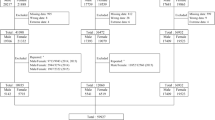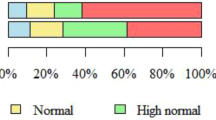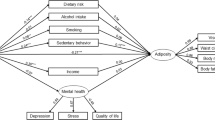Abstract
Objective: Investigation of the relationship between educational level, body mass index (BMI), waist-to-hip ratio (WHR), physical activity and parity in a group of Iranian men and women living in Tehran.
Design: A cross-sectional study in a group of Iranian men and women. The subjects were classified into two educational levels: low education (≤12 y schooling) and high education (>12 y schooling); and BMI, WHR, physical activity and parity (in women) were compared in two groups in men and women, separately.
Setting: Metabolic Unit of Tehran University of Medical Sciences in Tehran.
Subjects: Three hundred and fifteen men aged 33.1 (22–46) and 403 women aged 27.9 (22–45).
Results: After controlling for age and smoking, women with a higher level of education showed a significantly lower mean BMI than less educated women (24.8±4.2 vs 28.3±4.9, P<0.01), while more educated men had a higher mean BMI than less educated men (28.4±4.3 vs 26.7±4.5). In multiple regression analysis, physical activity in leisure time in men and years of education in women were the only determinants of BMI. After controlling for BMI, WHR was not related to the level of education in either men or women.
Conclusions: The present data indicated an educational difference in BMI for the study population. In Iranian women, like the women in developed countries, the level of education was negatively related to BMI, while in men the association was positive.
Sponsorship: This work was financially supported by the Institute of Public Health, Tehran University of Medical Sciences.
This is a preview of subscription content, access via your institution
Access options
Subscribe to this journal
Receive 12 print issues and online access
$259.00 per year
only $21.58 per issue
Buy this article
- Purchase on Springer Link
- Instant access to full article PDF
Prices may be subject to local taxes which are calculated during checkout

Similar content being viewed by others
References
Al-Mannai A, Dickerson JW, Morgan JB & Khalfan H (1996): Obesity in Bahraini adults. J. R. Soc. Health 116, 37–40.
Al-Nuaim AR, al-Rubeaan K, al-Mazrou Y, al-Attas O, al-Deghari N & Khoja T (1996): High prevalance of overweight and obesity in Saudi Arabia. Int. J. Obes. Relat. Metab. Disord. 20, 547–552.
Al-Nuaim AA, Bamgboye EA, al-Rubeaan KA & al-Mazrou Y (1997): Overweight and obesity in Saudi Arabian adult population, role of socio-demographic variables. J. Community Health 22, 211–223.
Baecke JAH, Burema J & Frijters JER (1982): A short questionnaire for the measurement of habitual physical activity in epidemiological studies. Am. J. Clin. Nutr. 36, 936–942.
Bjorkelund C, Lissner L, Andersson S, Lapidus L & Bengtsson C (1996): Reproductive history in relation to relative weight and fat distribution. Int. J. Obes. Relat. Metab. Disord. 20, 213–219.
Brown JE, Kaye SA & Folsom AR (1992): Parity-related weight change in women. Int. J. Obes. Relat. Metab. Disord. 16, 627–631.
Croff JB, Strogatz DS, James SA, Keenan NL, Ammerman AS, Mararcher AM & Haines PS (1999): Socioeconomic and behavioral correlates of body mass index in black adults: The Pitt County Study. Am. J. Public Health 82, 821–826.
Flegal KM, Harlan WR & Landis R (1988): Secular trends in body mass index and skinfold thickness with socioeconomic factors in young adult men. Am. J. Clin. Nutr. 48, 544–551.
Galobardes B, Morabia A & Bernstein MS (2000): The differential effect of education and occupation on body mass and overweight in a sample of working people of the general population. Ann Epidemiol. 10, 532–537.
Garn SM, Sullivan TV & Hawthorne VM (1989): Educational level, fatness and fatness differences between husbands and wives. Am. J. Clin. Nutr. 50, 740–745.
Kaye SA, Folsom AR, Jacobs JR, Hughes GH & Flack JM (1993): Psychosocial correlates of body fat distribution in black and white young adults. Int. J. Obes. Relat. Metab. Disord. 17, 271–277.
Kooy K & Seidell JC (1993): Techniques for the measurement of visceral fat: a practical guide. Int. J. Obes. Relat. Metab. Disord. 17, 178–196.
Lahmann PH, Lissner L & Gullberg B (2000): Sociodemographic factors associated with long-term weight gain, current body fatness and central adiposity in Swedish women. Int. J. Obes. Relat. Metab. Disord. 24, 685–694.
Molarius A, Seidell JC, Sans S, Tuomilehto J & Kuulasmaa K (2000): Educational level, relative body weight, and changes in their association over 10 years: an international perspective from the WHO MONICA Project. Am. J. Public Health 90, 1260–1268.
Pishdad GR (1996): Overweight and obesity in adults aged 20–74 in Southern Iran. Int. J. Obes. Relat. Metab. Disord. 20, 963–965.
Popkin BM, Paeratakul S, Zhai F & Ge K (1995): Dietary and environmental correlates of obesity in a population study in China. Obes. Res. 3, 135S–143S.
Rissanen AM, Heliovaara M, Knekt P, Reunanen A & Aromaa A (1991): Determinants of weight gain and overweight in adult Finns. Eur. J. Clin. Nutr. 45, 419–430.
Rosmond R & Bjorntorp P (1999): Psychosocial and socio-economic factors in women and their relationship to obesity and regional body fat distribution. Int. J. Obes. Relat. Metab. Disord. 23: 138–145.
Rosmond R, Lapidus L & Bjorntorp P (1996): The influence of occupational and social factors on obesity and body fat distribution in middle-age men. Int. J. Obes. Relat. Metab. Disord. 20: 599–607.
Seidell JC (1991): Environmental influences on regional fat distribution. Int. J. Obes. Relat. Metab. Disord. 15: 31–35.
Stam-Moraga MC, Kolanowski J, Dramaix M, De Backer G & Kornitzer MD (1999): Sociodemographic and nutritional determinants of obesity in Belgium. Int. J. Obes. Relat. Disord. 23, 1–19.
Tavani A, Neigri E & Vecchia CL (1994): Determinants of body mass index: a study from North Italy. Int. J. Obes. Relat. Metab. Disord. 18, 497–502.
Troisi RJ, Heinold JW, Vokonas PS & Weiss S (1991): Cigarette smoking, dietary intake, and physical activity: effect on body fat distribution—the normative aging study. Am J Clin Nutr. 15, 775–780.
Van Lenthe FJ, Droomers M, Schrijvers CT & Mackenbach JP (2000): Socio-demographic variables and 6 year change in body mass index: longitudinal results from the GLOBE study. Int. J. Obes. Relat. Metab. Disord. 24, 1077–1084.
Williamson DF, Madans J, Pamuk E, Flegal KM, Kendrick JS & Serdula MK (1994): A prospective study of childbearing and 10-year weight gain in US white women 25 to 45 years of age. Int. J. Obes. Relat. Metab. Disord. 18, 561–569.
Woo J, Leung SSF, Ho SC, Sham A, Lam TH & Janus ED (1999): Influence of educational level and marital status on dietary intake, obesity and other cardiovascular risk factors in a Hong Kong Chinese population. Eur. J. Clin. Nutr. 53, 461–467.
World Health Organization (1997): The World Health Report 1997. Obesity. Preventing and Managing the Global Epidemic. Geneva: World Health Organization.
Acknowledgements
We thank Dr G Soutoodeh for her help in collecting data. This work was financially supported by the Institute of Public Health, Tehran University of Medical Sciences.
Author information
Authors and Affiliations
Contributions
Guarantor: M Maddah
Contributors: MM—concept of work and writing of the paper. MRE—helped in data analysis. AD and RM—collected data.
Corresponding author
Rights and permissions
About this article
Cite this article
Maddah, M., Eshraghian, M., Djazayery, A. et al. Association of body mass index with educational level in Iranian men and women. Eur J Clin Nutr 57, 819–823 (2003). https://doi.org/10.1038/sj.ejcn.1601615
Received:
Revised:
Accepted:
Published:
Issue Date:
DOI: https://doi.org/10.1038/sj.ejcn.1601615
Keywords
This article is cited by
-
Epidemiology of diabetes mellitus, pre-diabetes, undiagnosed and uncontrolled diabetes in Central Iran: results from Yazd health study
BMC Public Health (2020)
-
Estimating the agreement between the metabolic rate calculated from prediction equations and from a portable indirect calorimetry device: an effort to develop a new equation for predicting resting metabolic rate
Nutrition & Metabolism (2018)
-
Health of Psychiatry Residents: Nutritional Status, Physical Activity, and Mental Health
Academic Psychiatry (2016)
-
Physical activity and body mass index in elderly Iranians in Sweden: a population-based study
European Journal of Clinical Nutrition (2008)
-
Bone mineral density, body mass index and cigarette smoking among Iranian women: implications for prevention
BMC Musculoskeletal Disorders (2005)



